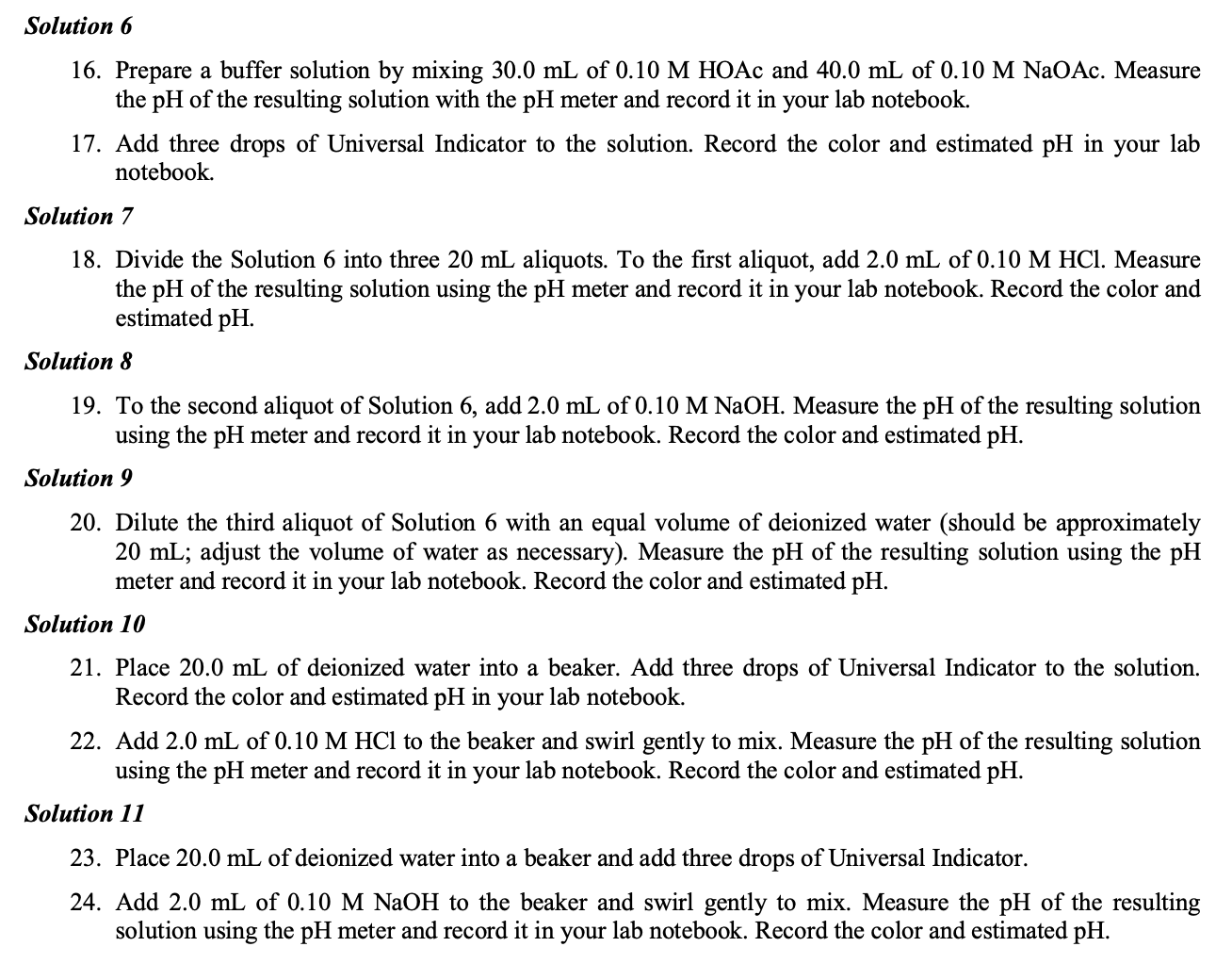Solution 6 16. Prepare a buffer solution by mixing 30.0 mL of 0.10 M HOẠC and 40.0 mL of 0.10 M NaOAc. Measure the pH of the resulting solution with the pH meter and record it in your lab notebook. 17. Add three drops of Universal Indicator to the solution. Record the color and estimated pH in your lab notebook. Solution 7 18. Divide the Solution 6 into three 20 mL aliquots. To the first aliquot, add 2.0 mL of 0.10 M HCI. Measure the pH of the resulting solution using the pH meter and record it in your lab notebook. Record the color and estimated pH. Solution 8 19. To the second aliquot of Solution 6, add 2.0 mL of 0.10 M NAOH. Measure the pH of the resulting solution using the pH and record it in your lab notebook. Record the color and estimated pH. Solution 9 20. Dilute the third aliquot of Solution 6 with an equal volume of deionized water (should be approximately 20 mL; adjust the volume of water as necessary). Measure the pH of the resulting solution using the pH meter and record it in your lab notebook. Record the color and estimated pH. Solution 10 21. Place 20.0 mL of deionized water into a beaker. Add three drops of Universal Indicator to the solution. Record the color and estimated pH in your lab notebook. 22. Add 2.0 mL of 0.10 M HCl to the beaker and swirl gently to mix. Measure the pH of the resulting solution using the pH meter and record it in your lab notebook. Record the color and estimated pH. Solution 11 23. Place 20.0 mL of deionized water into a beaker and add three drops of Universal Indicator. 24. Add 2.0 mL of 0.10 M NAOH to the beaker and swirl gently to mix. Measure the pH of the resulting solution using the pH meter and record it in your lab notebook. Record the color and estimated pH.
Ionic Equilibrium
Chemical equilibrium and ionic equilibrium are two major concepts in chemistry. Ionic equilibrium deals with the equilibrium involved in an ionization process while chemical equilibrium deals with the equilibrium during a chemical change. Ionic equilibrium is established between the ions and unionized species in a system. Understanding the concept of ionic equilibrium is very important to answer the questions related to certain chemical reactions in chemistry.
Arrhenius Acid
Arrhenius acid act as a good electrolyte as it dissociates to its respective ions in the aqueous solutions. Keeping it similar to the general acid properties, Arrhenius acid also neutralizes bases and turns litmus paper into red.
Bronsted Lowry Base In Inorganic Chemistry
Bronsted-Lowry base in inorganic chemistry is any chemical substance that can accept a proton from the other chemical substance it is reacting with.
Calculate the expected pH based on how the solution was prepared, again allowing for any dilution taking place. For Solutions 7 and 8, make sure to take into account the acid–base reaction that occurs when an acid or base is added to the buffer.

Trending now
This is a popular solution!
Step by step
Solved in 10 steps with 10 images









